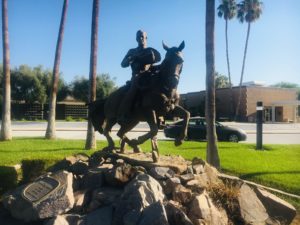The Palm Springs City Council on Wednesday, Sept. 29, will consider a Human Rights Commission draft resolution to apologize for the city’s role in the actions associated with Section 14.
PALM SPRINGS — The potential removal of the prominent Frank Bogert statue in front of City Hall on Tahquitz Avenue has sucked most of the oxygen out of the air surrounding the special meeting n Wednesday, but equally important is the City Council’s preparedness to apologize for the city’s role in the actions associated with Section 14.
Section 14 is one of the less glamorous chapters in the history of Palm Springs known around the world as a tourist destination and a favorite hangout of Hollywood stars. Section 14 involved he forced eviction of minority families from tribal land known as Section 14 in the 1950s and 1960s.
Black and Latino families for decades rented land from the Agua Caliente Band of Cahuilla Indians on Section 14, a 1-square mile section of land bound by what is now Indian Canyon Drive to the west, Ramon Road to the south, Sunrise Way to the east and Alejo Road to the north.
Racial residential segregation was prevalent in Palm Springs, and land leasing laws prevented the Agua Caliente from developing their land, so the tribe rented out land on Section 14 to many Black and Latino families.
After federal law changed in 1959 to allow 99-year leases on tribal land instead of the short-term five-year leases that were previously allowed, the city became interested in commercial development on Section 14.
Starting in 1959, the city removed residents from their homes to make way for commercial development. Some of those who were evicted reported never receiving any notice before their homes were burned down or demolished.
But others say Bogert had a reputation for racist and discriminatory comments and point to his actions and comments on Section 14.
Bogert served as mayor during the razing of homes on Section 14, a plot of land east of downtown Palm Springs that is part of the Agua Caliente Band of Cahuilla Indians reservation. The city paid for the razing. It appears that the first evidence of evictions of residents from Section 14 began in late 1954, and continued for the following 12 years, through 1966. Frank Bogert became Mayor of the City of Palm Springs in 1958, serving until 1966. He was elected Mayor again in 1982 and served until 1988.
Until now, the City Council has never officially apologized. Those who seem ready to do it are: Mayor Christy Holstege, Mayor Pro Tem Lisa Middleton, Councilmembers Geoff Kors, Dennis Woods and Grace Garner.
According to a draft Resolution from the Human Rights Commission, which the City Council will consider, “The Frank Bogert Monument which stands in front of City Hall is a hurtful symbol of systemic racism and the significance of being the only monument at City Hall makes this symbolism even more hurtful, the current Palm Springs City Council has declared systemic racism a public health crisis, and the city has authority over public property to relocate the Frank Bogert Monument.
The Resolution also states that he City of Palm Springs is committed to promoting racial equity and justice, and desire to advance social equity, diversity, inclusion, and fairness and to work to address and undo systemic racism and its continuing impacts.

Frank Bogert Statue
“With an understanding that it takes many good deeds to build a good reputation, and only one bad one to lose it. actions of racial bias, segregation and terror brought on a community. The City of Palm Springs Human Rights Commission desires to move the Frank Bogert Monument from in front of City Hall,” the Resolution states.
Members of the Palm Springs City Human Rights Commission recommend the Palm Springs City Council order the immediate removal of the Frank Bogert Monument from the front of Palm Springs City Hall.
Said removal is to be completed within 90 days from the date of full adoption of this resolution.
The cost to remove the Frank Bogert Monument is approximately $6,000 – $11,000, with the cost to remove and re-install the Monument at an alternate location approximately $12,000 – $22,000. As the Monument is part of the City’s Public Arts Collection, any necessary funding would be appropriated from the Public Arts Fund Budget. There are sufficient funds available in the current fiscal year, according to a staff report.
Image Sources
- Frank Bogert Statue: Cindy Uken
- Apology: Shutterstock




![Enrolling Now, Rewarding Careers Ahead [Sponsored]](https://ukenreport.com/wp-content/uploads/2024/04/COD_heroes_1-1385-2-440x264.jpg)


